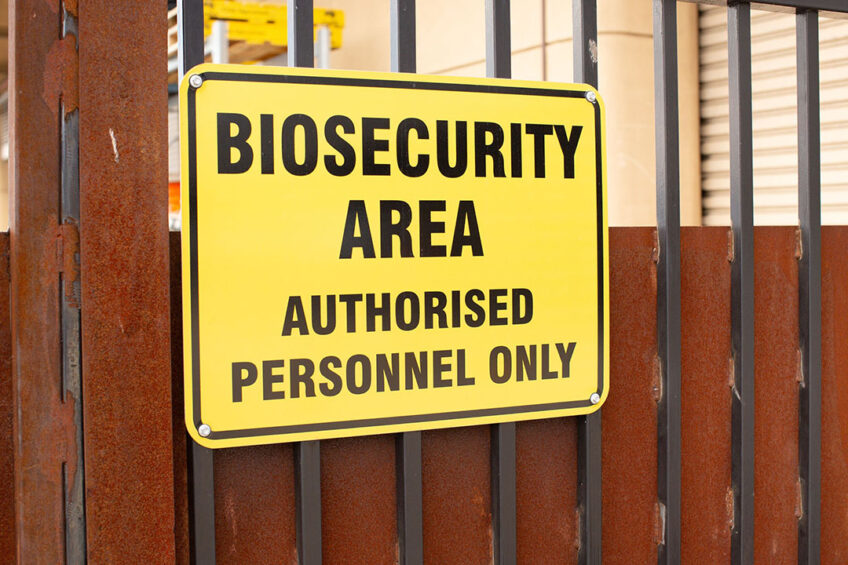Biosecurity – the inner shell strategy against bird flu

Good biosecurity around poultry housing will bring a 44-fold reduction in the risk of avian influenza infection, according to the UK’s chief veterinary officer Christine Middlemiss.
Defra epidemiologists who have looked at outbreaks on free-range egg farms have found that the weaknesses are generally within the inner shell of the farm, particularly around entrances to houses, and the lack of a lobby with separate clean/dirty areas.
They also highlighted no dedicated house PPE, poor foot dip locations, incorrect dilution and no dedicated brush, no washbasin or hand sanitiser, and a lack of secure doors. Issues have been found in the egg room where it serves as a lobby into the poultry accommodation. Staff working in the egg room can then be responsible for the transmission of the virus into the house via the egg belt.
St David’s Poultry say biosecurity measures should reduce the risk to a flock the closer you get to the house. When considering or planning the approach, they say the 3 key stages to consider are:
- Site planning – conceptual
- Building design – structural
- Site management – operational
For site design, things to consider include:
- Access routes – have a single point of access, gates and secure with vehicle washing and disinfection, plus foot dip and sign-in for all passing on to site.
- Proximity to waterways
- Proximity to migratory birds – make the site as unattractive as you can to wild birds, e.g., anti-perching devices, enclosed storage for feed and bedding, etc.
- Drainage – try to ensure natural drainage to prevent pooling of water on the range, when locating new houses
- Distance – from other farms, public footpaths, roads and the amount of poultry traffic there is or will be.
Building design
The need to prevent wild animals and birds accessing the flock is well known and is really important in the prevention of the spread of avian influenza. The virus survives well in wet conditions and can be easily transported around a site. For example, water can collect on concrete aprons, parking areas and approach paths with flaws in a building’s structure allowing leakage in the flock housing. Preventing the ingress of this potentially contaminated water is vital to defend the flock. Top tips include:
- Drainage – Doors with level access must be protected against water ingress. Think about using sandbags to keep water away from the base of doors.
- Materials used – Easy to clean and maintain, reduce ingress and serve as a barrier to wildlife, such as rodents. Ensure doors, vents, intakes and ducts are all sealed into the building structure preventing wildlife and rainwater from accessing the flock.
- Feed augers and muck conveyors – Check they are well sealed, both in to and out of the building.
- Roof structure – is it wind and watertight and there are no leaks?
- Roof ventilation – ensure it is enclosed so wild birds cannot nest
- Tunnel vents – rather than side vents to avoid uncapped vertical fan vents.
- Gutters – should be high capacity easy to access for cleaning, with sealed piped discharge taking contaminated roof water away from the house.
- Water collection and containment – wash down water must be collected and disposed of away from housing and range as it poses a high risk to subsequent flocks. Where statutory cleansing and disinfection is required, all wash water has to be collected for disposal.
- Single age sites – sites with single buildings are easier to defend. Consider covered access where multiple houses are accessed from outside.
- Single access points – Sites and housing should have single points of entry. Where multiple houses are on a single site, enclosed access should be considered to avoid necessity for external access. Step overs and biosecurity between houses are vital to protect the inner shell.
- Rodents – Physically prevent access and ensure there are no harbourages nearly poultry units.
Site management
Having the correct procedures and operational attitudes are vital and among the issues to consider are having a biosecurity policy that ensure measures are accessible and easy to maintain with regular training. There should be a named biosecurity officer for each site and breaches must be recorded. There should be clear signage along with a site access plan/map. Visitors should be kept to a minimum and they should all be recorded.
Remember to include wheel washing, a terminal hygiene programme and incorporate double step over barrier. Tools and equipment must be cleaned and disinfected before being used in poultry areas.












